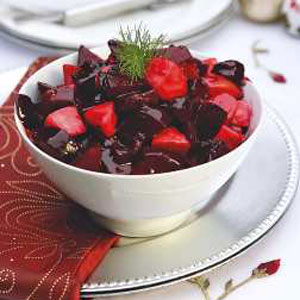Despite its intense colour, remarkable flavour and long list of
culinary uses, beetroot is an underrated vegetable. In ancient
civilisations only the leaves were eaten, with the roots being used for
medicinal purposes, and the Romans are credited with having introduced
the roots to the table.
Today many of us are still not adventurous enough when it comes
to this versatile vegetable, often only going so far as buying bottles of
pickled beetroot. As a result, we miss out on all the wonderful flavours.
Here are some guidelines to help you choose,store and prepare fresh beetroot.
Choosing
Beetroot is
available throughout the year and should preferably be purchased in a
bunch with fresh leaves. The spheres should be hard and similar in
size, normally fist-sized or, for the baby ones, the size of golf
balls. Buy the small beetroot if possible as they have a more intense,
sweeter flavour. The leaves are a good indication of the freshness of
the beetroot so check them to ensure you buy the freshest bunch
available.
Storing Beetroot keeps
well for a
few weeks. Remove the leaves by cutting them off about 10cm from the
root (if you do not remove the leaves they will rot and cause the roots
to spoil). Wash the earth off the roots without breaking the skin,
making sure you leave the tapered root at the base intact.
Cooked beetroot can be added to mashed potato, turned into soup or used
to colour homemade pasta. Once cooked, beetroot will keep in the fridge
for two to three days.
In the oven – Preheat oven to 170 degrees C and prepare
beetroot,leaving the skin on,trimming the stalk to 2,5cm and leaving
the tapered root intact.
Place on a layer of heavy-duty foil and seal to form a parcel. Place on
a baking tray and bake for three hours. You should be able to ease
the skin away with your thumbs when it is cooked.
Boiled – Use small beetroot for this method of preparation.
Prepare as
above and place in a saucepan. Add enough boiling water to just cover
and a little salt. Cover the saucepan and simmer for about 20 minutes
until you can ease off the skin. Leaving the beetroot unpeeled during
boiling will stop the red pigment, called betacyanin, from bleeding.
Peel and serve hot as a side dish, or use in a salad or in a recipe
requiring
cooked beetroot. Young beetroot leaves with red spines and veins make a
pretty addition to salads, or can be prepared in the same way.
In the microwave – Beetroot cook very successfully in the microwave, cook two beetroot, wrapped in cling wrap, for six to eight minutes on high.
5 things to do with beetroot
Beetroot and green bean salad

